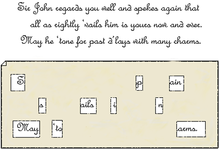Cardan grid
The " Cardan lattice ", which was invented by the Italian mathematician Gerolamo Cardano around the year 1550 and named after him, played an important role in the encryption of messages in the early modern era . From the point of view of modern cryptography , it is a steganography procedure .
A grid is drawn on a writing pad (parchment, paper, etc.). Some of the fields in the resulting table are then cut out of the carrier. This creates a "perforated template", i.e. a template , here a so-called individual cardan grid .
In order to encrypt a text using the template, which is individual Cardan grille placed on a blank piece of paper, and only at the points where the template is "full of holes", the verbal pieces, syllables, letters or other transcriptions dismantled Embassy, registered. The rest of the table can be filled with any data.
The individual Cardan grid is required to decipher the message .
Nowadays the functionality of the Cardan grating is still often used in connection with steganography .
Literature example
This covert communication plays a consistently important role in the science fiction novel Atomgewicht 500 by Hans Dominik , published in 1934/35 :
"Mr. Spinner sat down at the desk and picked up the quill to write a letter to Tom White. It turned into a letter of several pages, and anyone reading the text as it was on the paper was bound to get the impression that some talkative old uncle was serving up endless family stories for his nephew. But the picture changed significantly if you read a cardboard template that Spinner had lying next to you. Placed on one side of this whimsical letter, it covered most of the writing and left only a few words visible. Then something completely different was to be read in the letter. New deck addresses were found in it and an urgent reminder to be very careful with all further steps. "
Web links
Individual evidence
- ↑ Hans Dominik : Atomic weight 500 . Scherl-Verlag , Berlin 1934, from chapter 1 ( Gutenberg project https://www.projekt-gutenberg.org/dominik/atom500/index.html ).
